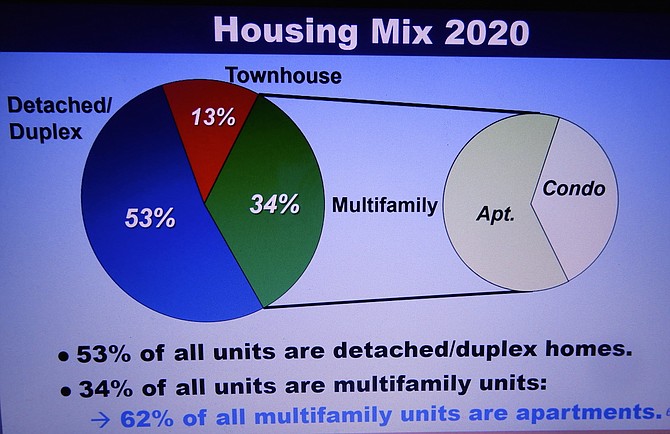In order to better plan for Fairfax City’s future, City Council recently received a detailed update on the housing picture. Making the presentation during a work session was Senior Planner Eric Forman.
With a City population of about 25,000, some 70 percent of the residents own their homes; the other 30 percent rent them. And currently, Fairfax has 1,100 housing units approved or under construction.
“Since our last housing assessment, around 2014, the City has approved 2,000 more units to our housing stock,” said Forman. “Of our 9,516 housing units, about 5,200 are detached or duplex homes. Over one-third are multifamily units – two-thirds of which are apartments.”
However, he added, “A big part of our story isn’t just what type of homes we have, but when they were built. About three-fourths of the City’s current stock of detached/duplex units were built in the 1950s and ’60s. Just 3 percent were built from 2010 through 2020.”
FAIRFAX’S FIRST TOWNHOUSES were built in the late 1960s – and then not again for 10 years. And the number of townhouses constructed in the last decade represent 17 percent of the whole, or about 220.
“Since 2014, the City has added over 1,000 multifamily units, including Scout on the Circle and the Kamp Washington apartments,” said Forman. “And they’re 29 percent of the City’s multifamily housing stock. The bulk of the detached homes are in the $400,000, $500,000 and $600,000 range in assessed value. And many of our homes have been occupied by the same people for 30 or more years.”
So in a possible attempt to diversify what’s available for residents here, Planning Division Chief Paul Nabti said City staff looked at five, alternative, housing types in other communities:
Cottage Housing: Small, clustered, detached houses with two or three bedrooms, including first-floor, master bedrooms. They may have recessed second stories with one or two bedrooms and may have less parking than typical houses.
Two-over-Two Condos: They look like a four-story townhouse, but are divided into two, two-story units of three or four bedrooms each. Both units have exterior entrances, with garages typically in the rear and accessible via an alley.
Townhouses with Elevators: Often marketed to senior citizens, each townhouse has three or four bedrooms. Elevators add approximately $20,000-$25,000 to the construction cost.
Detached, Accessory Dwelling Units: These are small houses on the same property as another house. They’re typically under 800 square feet, with one or two bedrooms, a kitchen and bathroom.
Senior Multifamily Units: The complexes have both senior-friendly floor plans, one or two bedrooms, plus common areas. Usually offered are housekeeping, recreational activities, dining and fitness and wellness programs. May also offer assisted-living and memory-care components.
“We’re forecasting high-end wage earners here,” said Councilmember Janice Miller. “So should we be building housing for these future residents?” Nabti said staff could examine that possibility.
“We have a lot of homes in the $575,000 to $675,000 price range,” added Miller. “So is the advantage of the two-over-two condos the new construction (since they’re in the same price range)?” Nabti replied affirmatively.
Meanwhile, Councilmember Sang Yi wanted to know, “How would detached accessory dwelling units be accepted by homeowners’ associations? Would a zoning ordinance supersede their requirements?”
“No,” answered Nabti. “It would more likely be applied to neighborhoods with civic associations, instead.”
Yi also wondered about the square footage of the cottages. “They don’t seem like much bang for the buck, especially since they’re expensive, have less parking and look pretty small,” he said.
Noting that “This is an interesting discussion because it’s relevant to our decisions regarding where we go from here,” Councilmember Tom Ross had questions, as well. “What is the future housing demand anticipated here?” he asked. “What do our residents want?” But both queries require further research by staff.
AS FOR HOME PRICES, “The trend of homes selling for higher than their asking prices has continued in the City in 2021,” said Forman. “Houses especially in the $400,000 and $500,000 range have sold for more than their assessed value. It’s our mid, price-point, and they’re in high demand, right now. And the same is true of our townhouses built in the ’60s and ’70s.”
“There’s demand for all types of housing,” he continued. “Although, currently, we’re not seeing quite that level of demand for condos. Fairfax City’s housing costs are similar to those in other Northern Virginia regions.”
Regarding rentals, Forman said, “One-third of the City’s apartments are rental units; and Fairfax City’s rents, on average, declined more in 2020 than in the immediately surrounding areas. They declined by 10.5 percent last year. The main reason was because of two apartment complexes where mainly GMU students lived. (They weren’t here because of the pandemic).”
“Clearly, housing is central to the future development of the City,” said Fairfax Mayor David Meyer. “It affects our transportation, economic development, education, etc., and it’s certainly dynamic.” He then asked Forman and Nabti to continue gathering data, return to the Council and recommend what the City should do to best position itself for the future.
Agreeing, Miller said she supports hiring a consultant “to direct us on what we should do, as we move forward.”
